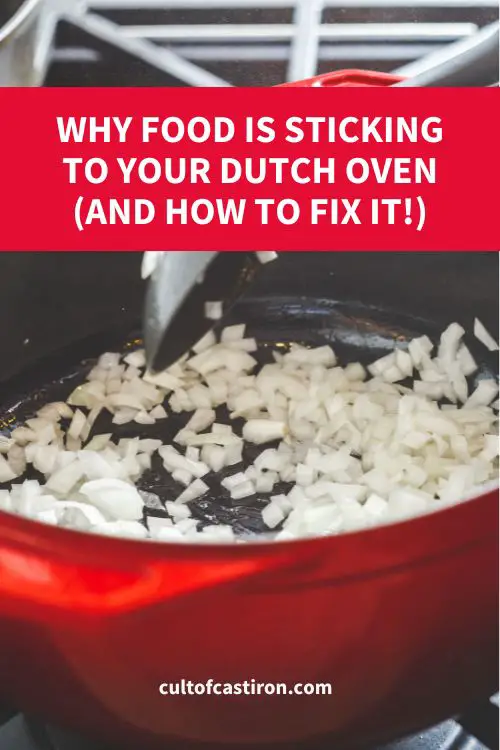If there is one thing I hate about enameled cast iron cookware like Dutch ovens, it’s that they do not have a sleek layer of seasoning to prevent food from sticking on to its surface.
Luckily, cleaning stuck on food on Dutch ovens is easy enough and does not damage its expensive enamel seasoning — It’s quite annoying to clean, though. Moreover, it may lead to stains on your Dutch oven — which is not the end of the world, but it may as well be especially if you’re concerned about aesthetics.
By understanding and applying a few key techniques, you can keep your Dutch oven in top shape and ensure a smooth cooking experience every time. Let’s explore some practical tips to help you avoid this common issue and maintain your Dutch oven’s pristine condition.
5 Common Reasons Why Food Sticks To Dutch Ovens
Here are the most common reasons why food sticks to the surface of your Dutch oven.
1. Insufficient preheating
One of the main reasons food sticks to enameled cast iron cookware is insufficient preheating – and it all has to do with the Maillard reaction. The Maillard reaction is a chemical process that occurs when proteins and sugars in food are exposed to heat, resulting in browning and the development of complex flavors. When your Dutch oven is not preheated properly, the surface temperature is too low to initiate the Maillard reaction efficiently. As a result, food sticks because it doesn’t form the necessary crust that helps it release from the surface.
Properly preheating your cookware ensures that the Maillard reaction occurs, creating non-stick crust that enhances your dish and makes cooking in your Dutch oven a more enjoyable experience. And of course, it makes your food delicious!
2. Inadequate amount of oil
Using an inadequate amount of oil can lead to food sticking to your Dutch oven. Oil creates a barrier between the food and the enamel surface, helping to prevent sticking. When cooking with enameled cast iron, it’s essential to use enough oil to coat the bottom of the pot evenly. If you use too little, the food can adhere to the surface and make cleaning more difficult.
3. Excessively high temperature setting
Cooking at excessively high temperatures is another common cause of food sticking to enameled cast iron. High heat can cause food to burn and stick to the enamel surface, making it challenging to clean and potentially damaging the cookware.
To avoid this, always cook at medium to medium-high heat unless a recipe specifically calls for higher temperatures. Enameled cast iron retains heat exceptionally well, so lower temperatures are often sufficient for cooking most dishes. By managing the heat appropriately, you can prevent sticking and prolong the lifespan of your Dutch oven.
4. Too much moisture
Excess moisture can contribute to food sticking in your Dutch oven. When there is too much liquid in the pot, it can prevent the food from searing properly and lead to sticking. To mitigate this issue, ensure that your ingredients are adequately dried before cooking, especially proteins like meat or fish. Additionally, avoid overcrowding the pot, as this can trap moisture and hinder proper browning. By controlling the moisture level and allowing the food to develop a good sear, you can reduce the chances of sticking and enhance the flavors of your dishes.
How To Clean Stuck On Food on Your Dutch Oven
Cleaning stuck-on food from your Dutch oven can be a daunting task, but with the right techniques, it can be done efficiently without damaging the enamel coating.
First, allow the Dutch oven to cool completely to avoid thermal shock, which can crack the enamel. Once cool, fill the pot with warm water and a few drops of dish soap, letting it soak for about 15-30 minutes. This helps to loosen the stuck-on food.
After soaking, use a non-abrasive sponge or a nylon brush to gently scrub the surface. Avoid using metal scrubbers or harsh abrasive cleaners, as these can scratch and damage the enamel. For stubborn stains or residue, make a paste with baking soda and water. Apply the paste to the affected areas and let it sit for 15 minutes before scrubbing gently with your sponge or brush.
If there are still some persistent spots, bring a mixture of water and a tablespoon of baking soda to a gentle boil in the Dutch oven. Let it simmer for a few minutes, then turn off the heat and allow the mixture to cool. This method helps to lift off the remaining residue. Finally, rinse the Dutch oven thoroughly with warm water and dry it completely before storing. This careful cleaning process will keep your Dutch oven in excellent condition, ready for your next culinary adventure.
Wrapping Up
Proper care and technique are essential for getting the most out of your enameled cast iron Dutch oven. Insufficient preheating, inadequate oil, high temperatures, excess moisture, and improper cooking methods can all lead to food sticking. By addressing these factors and employing the right cleaning methods, you can keep your Dutch oven in top condition. These practices not only enhance your cooking experience but also ensure that your Dutch oven remains a reliable and durable tool in your kitchen for years to come. With these insights, you can enjoy the full potential of your Dutch oven and its culinary benefits.
To learn more about cooking with cast iron, check out Cult of Cast Iron! Scroll through our blog dedicated to all things cast iron and find helpful tips and tricks to level up your cast iron skills! Discover a whole new world of cooking and spread the Cult of Cast Iron word today!

Miguel is a cast iron enthusiast from Cavite, Philippines. He works in the digital marketing field as a content marketing strategist. On the side, he manages a small online bookstore and tends to his plants.

